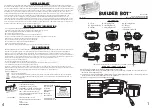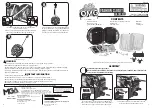
You can program the following registers:
Register Function
Available Factory
values
pre-set
CV1
Loco address
(00-22)
[3]
CV2
Starting voltage
(0-255)
[2]
voltage for speed setting 1 - if loco starts only at a
higher speed setting, increase value.
CV3
Acceleration (1 = fast, 255 = slow)
(1-255)
[3]
CV4
Braking (1 = fast, 255 = slow)
(1-255)
[3]
CV5
Max. voltage
(1-255)
[255]
Voltage for highest speed step - if a lower top speed is
desired, decrease value.
CV5
after input of CV6 (when programming with older
LGB 55015) function value for CV to be programmed
CV6
CV to be programmed (when programming with older
LGB 55015)
CV7
Reset of sound CVs
111: reset CV131-CV162; 122: reset CV171-CV187,
CV29
NMRA configuration
[4]
Bit programming
Bit 1: direction, 0 = normal, 1 = reversed [0]
Bit 2: speed steps, 0 = 14 (LGB), 2 = 28 [0]
Bit 3: analog operation, 0 = not possible, 4 = possible [4]
Bit 4: not used [0]
Bit 5: speed steps, 0 = factory-programmed,
16 = user-programmed [0]
Bit 6: address area, 0 = 0-127 (LGB), 32 = 128-10239 [0]
To program, add the values for the individual Bits and
program the resulting function value.
Hint: To program a loco to reversed direction of travel
(for example, F7 A-B-A combination),
program function value 5.
Attention! Loco addresses 128-10239 and 28 speed
steps cannot be used with LGB MTS).
CV49
Voltage for function terminal F1
(1-32)
[32]
(depends on loco model, do not change, as functions
can be affected or destroyed)
CV50
Voltage for lighting terminals (see CV49)
(1-32)
[5]
CV51
Command for function terminal F1
[13]
0 = lighting button 9
1 = button 1 (buttons 2-8 not used)
9 = button 1 (buttons 2-8 used as well)
10 = button 2
11 = button 3
12 = button 4
13 = button 5
14 = button 6
15 = button 7
16 = button 8
23
Summary of Contents for ABe 4/4 Railcar
Page 41: ......
















































